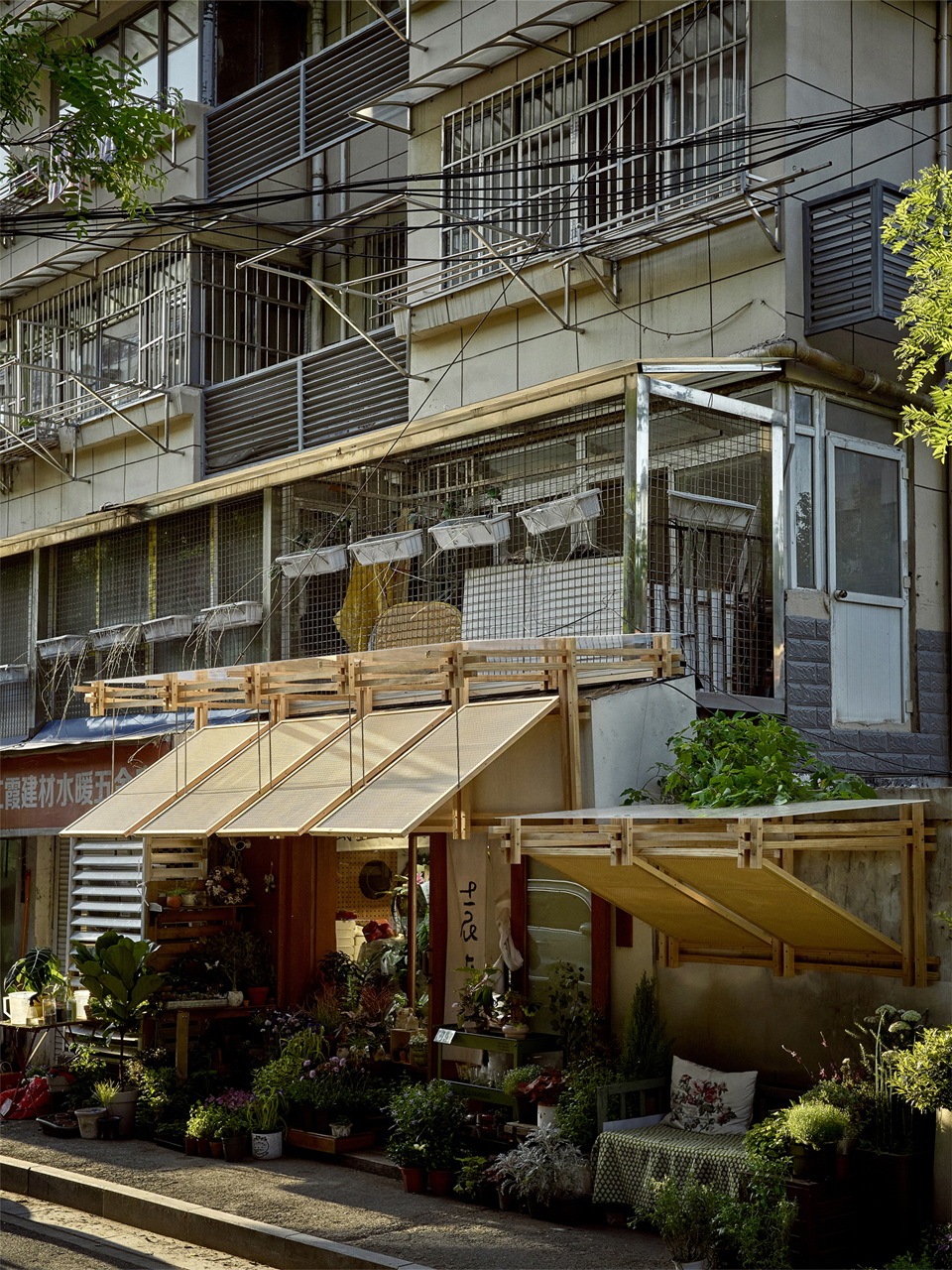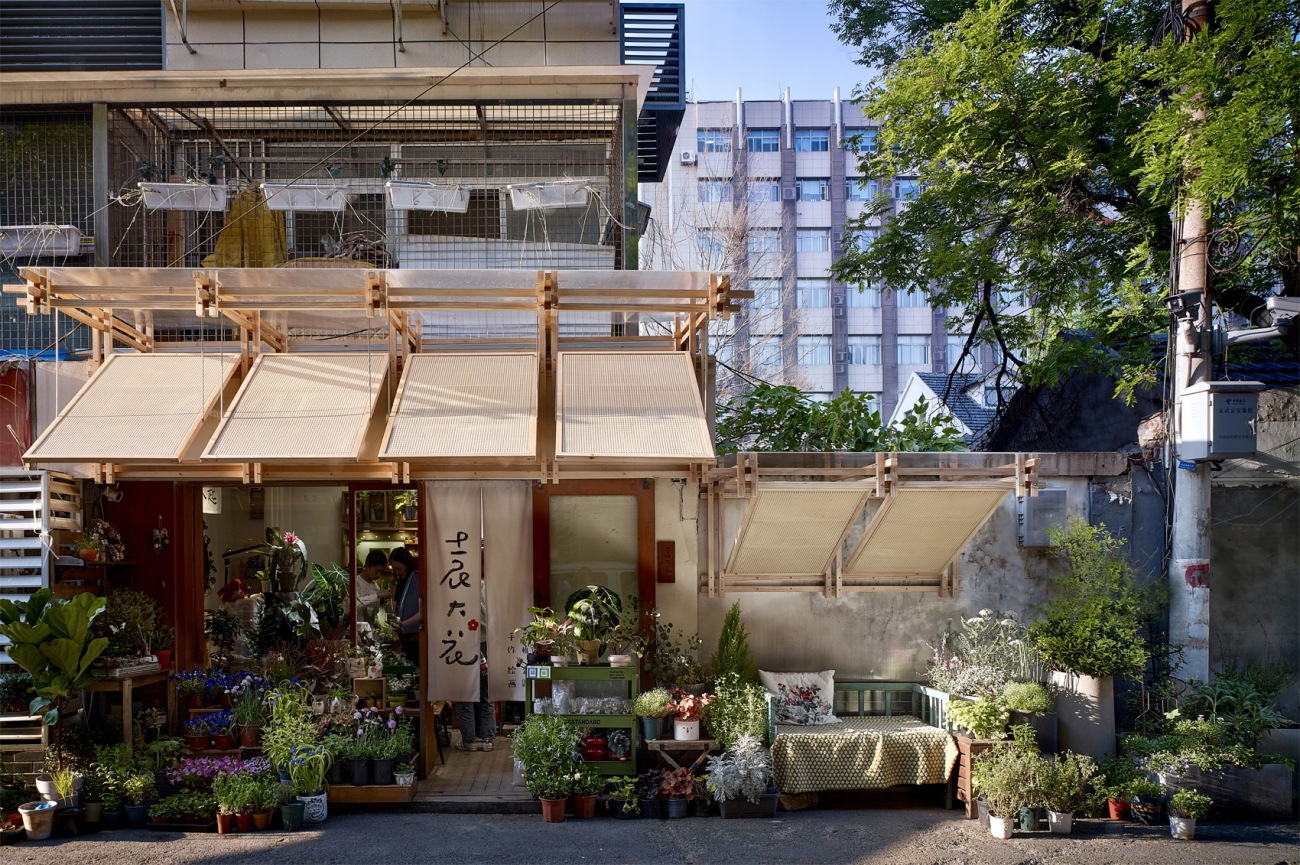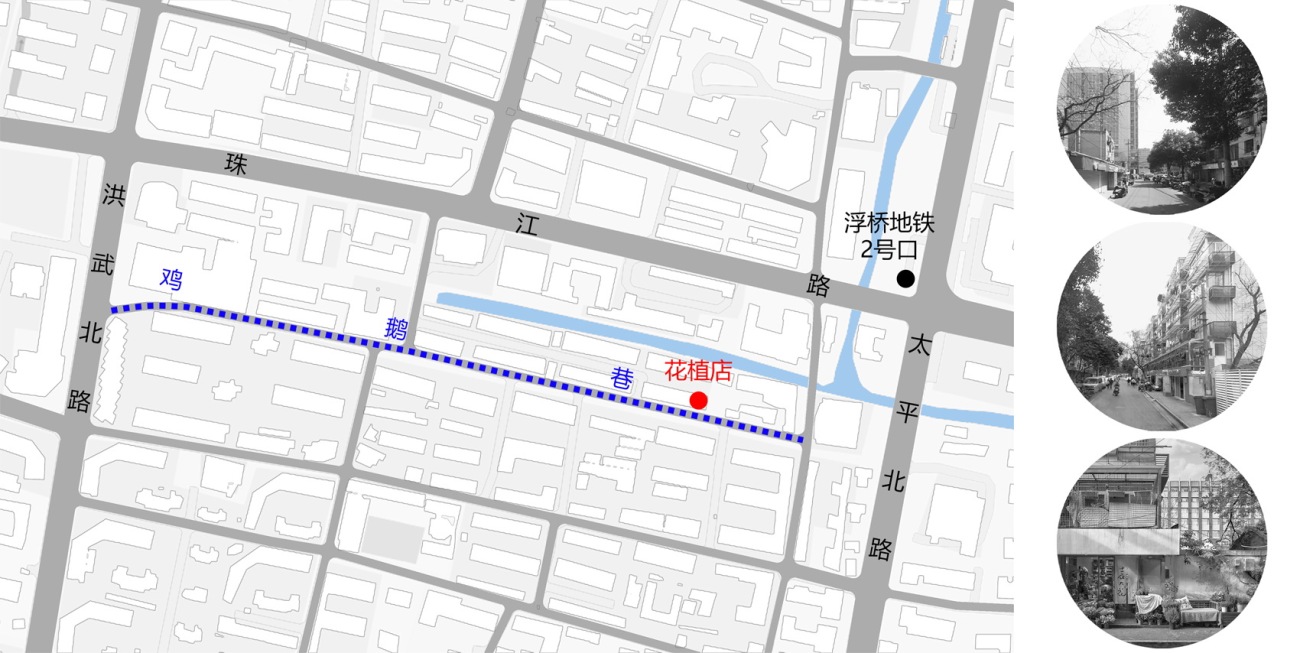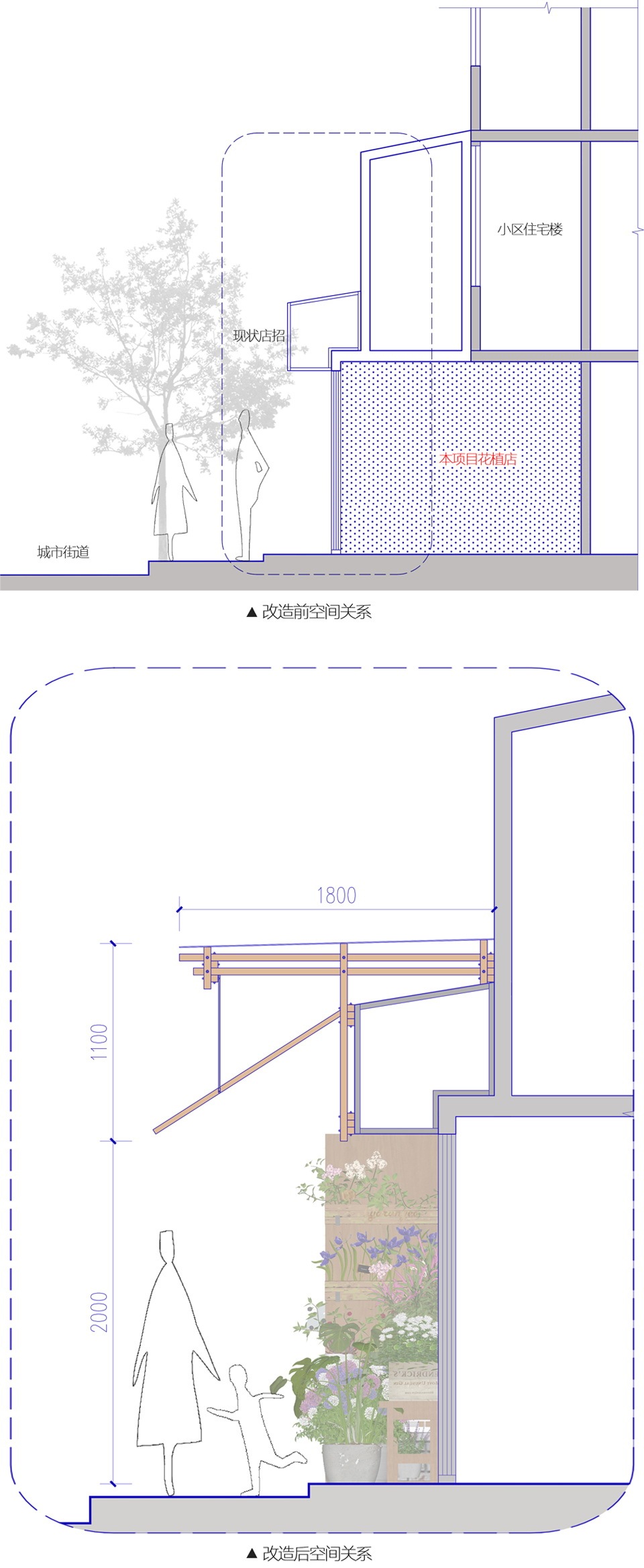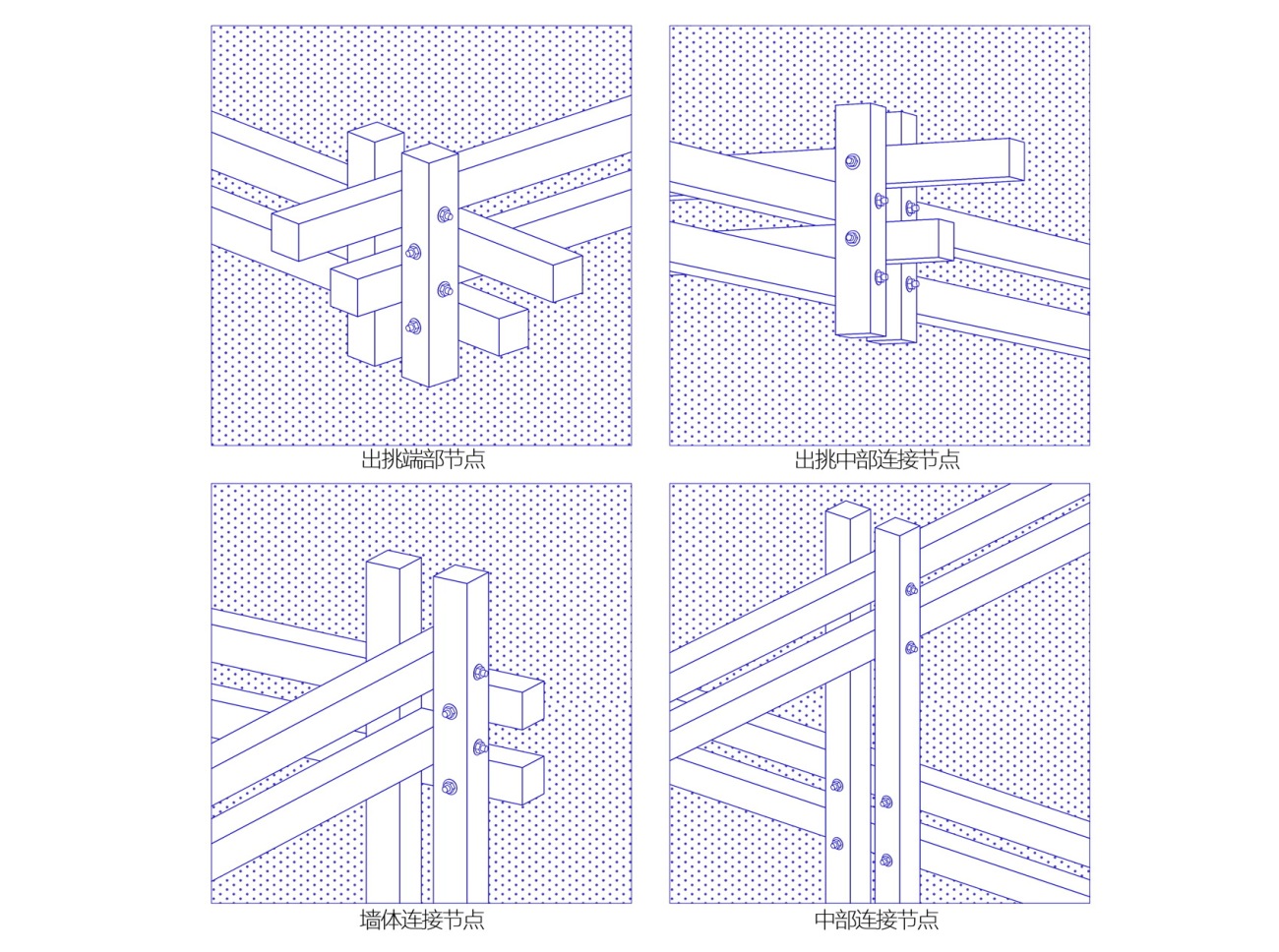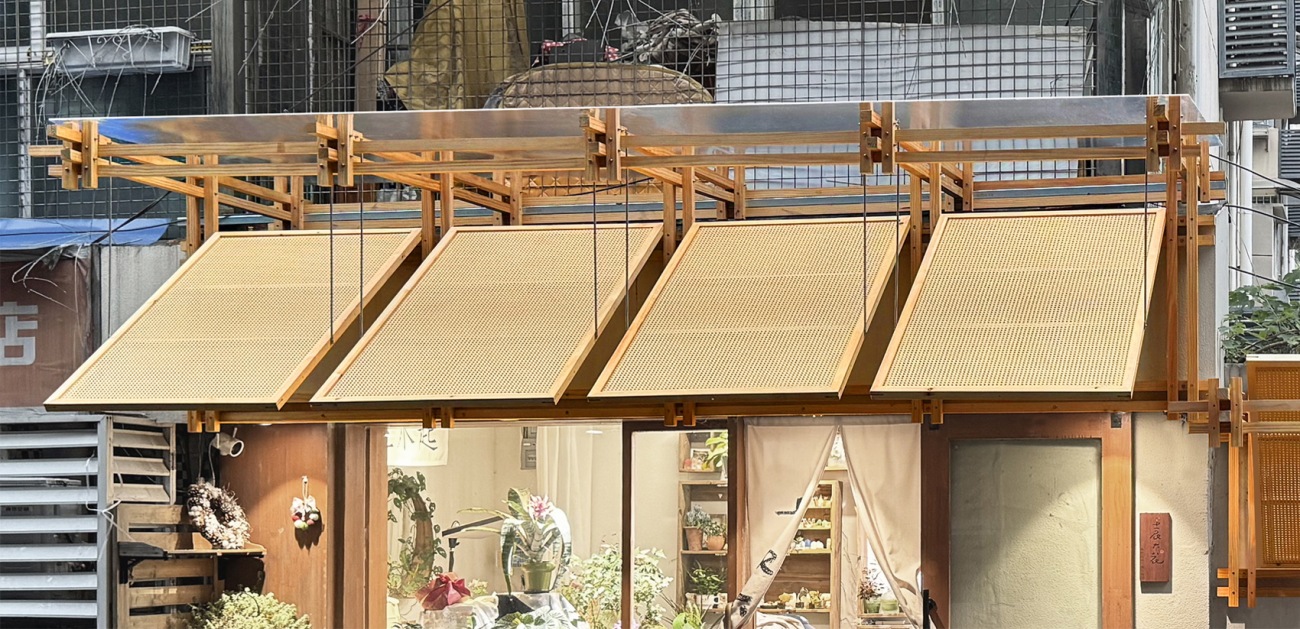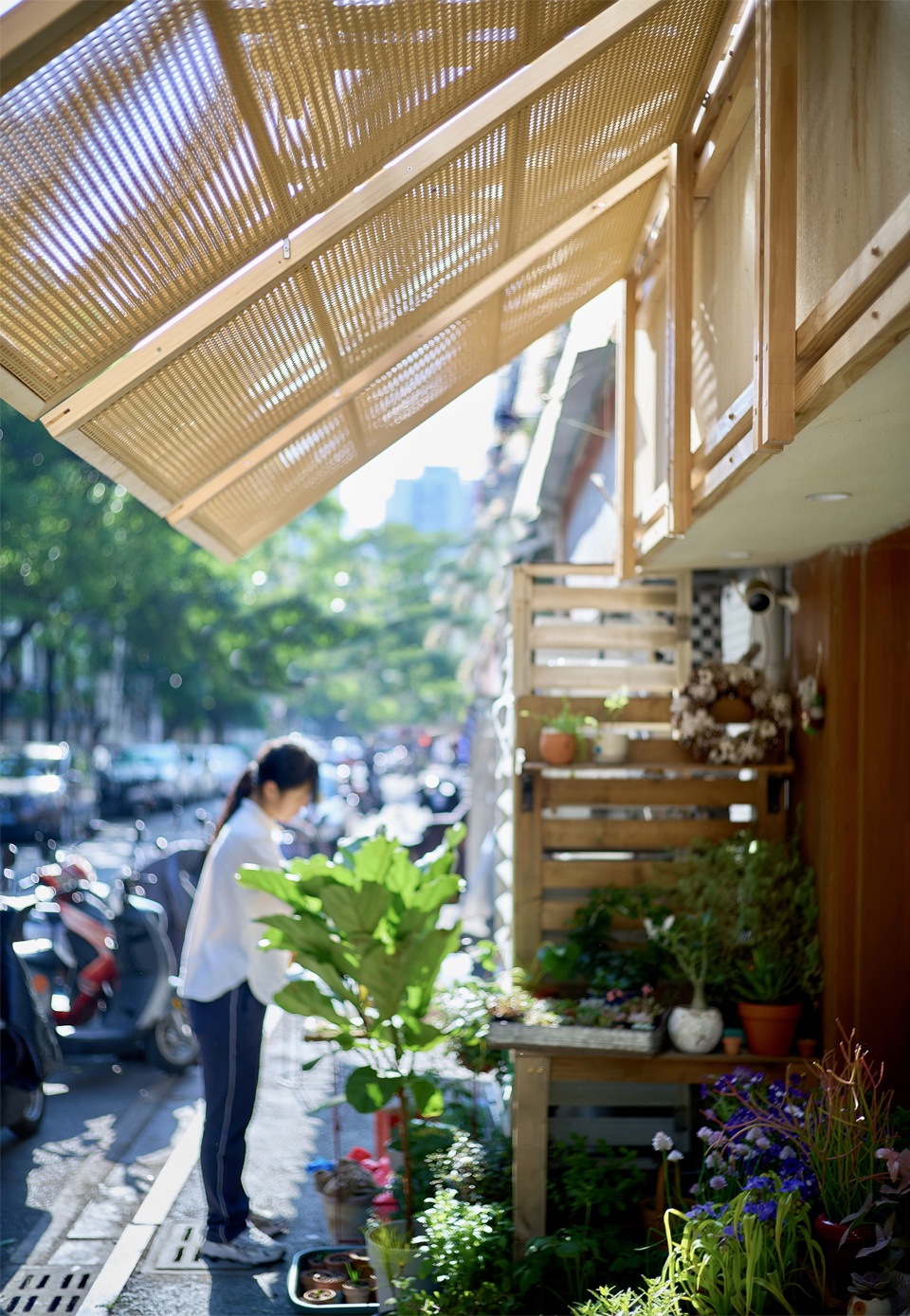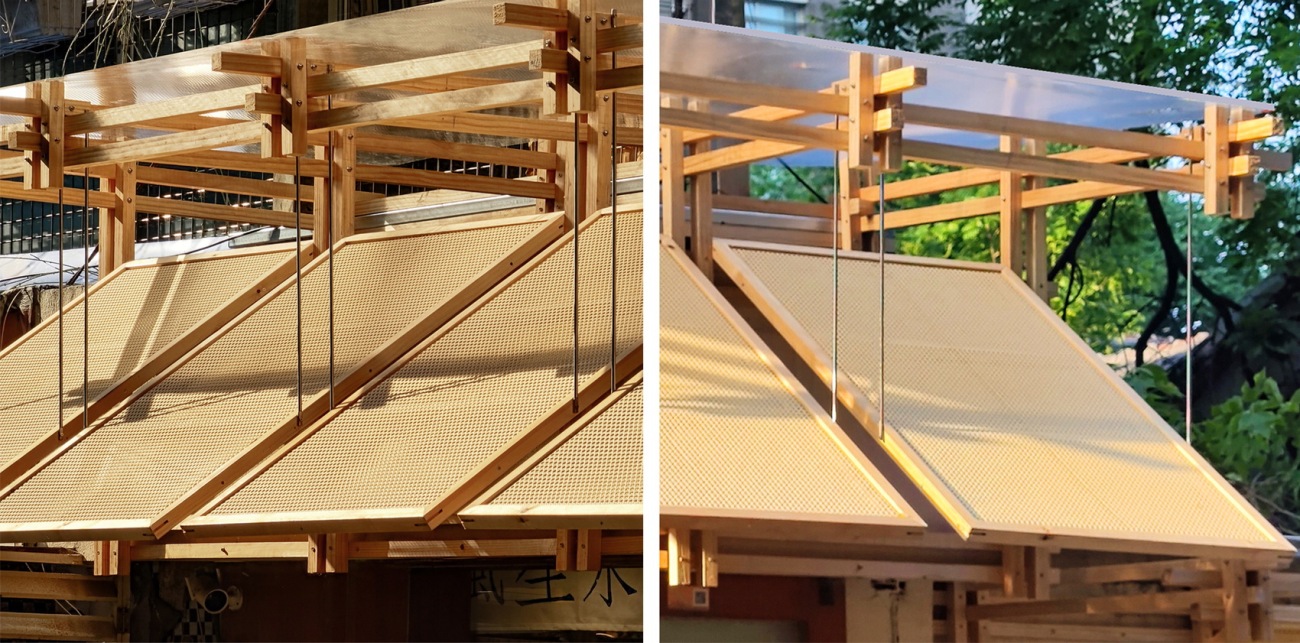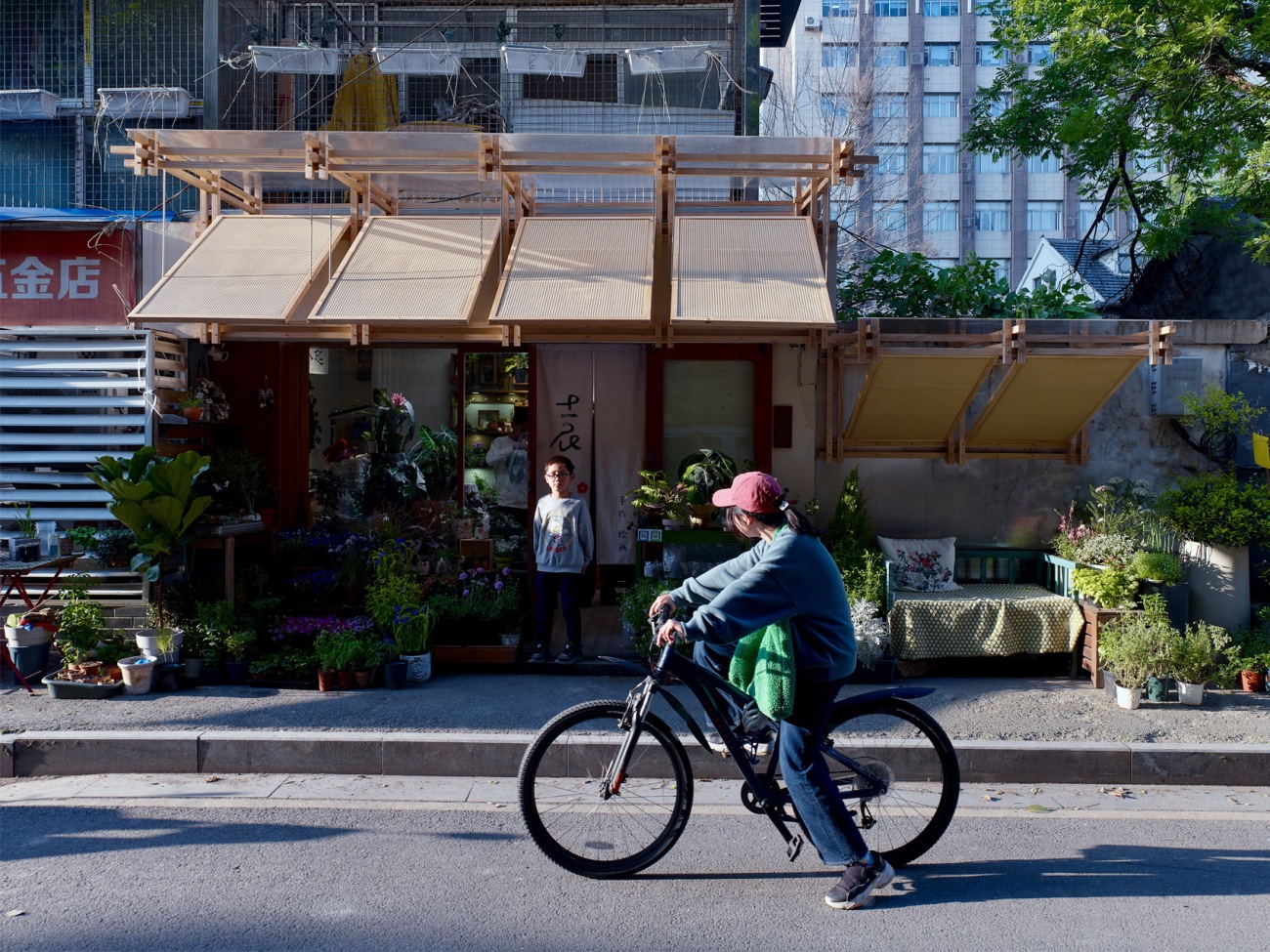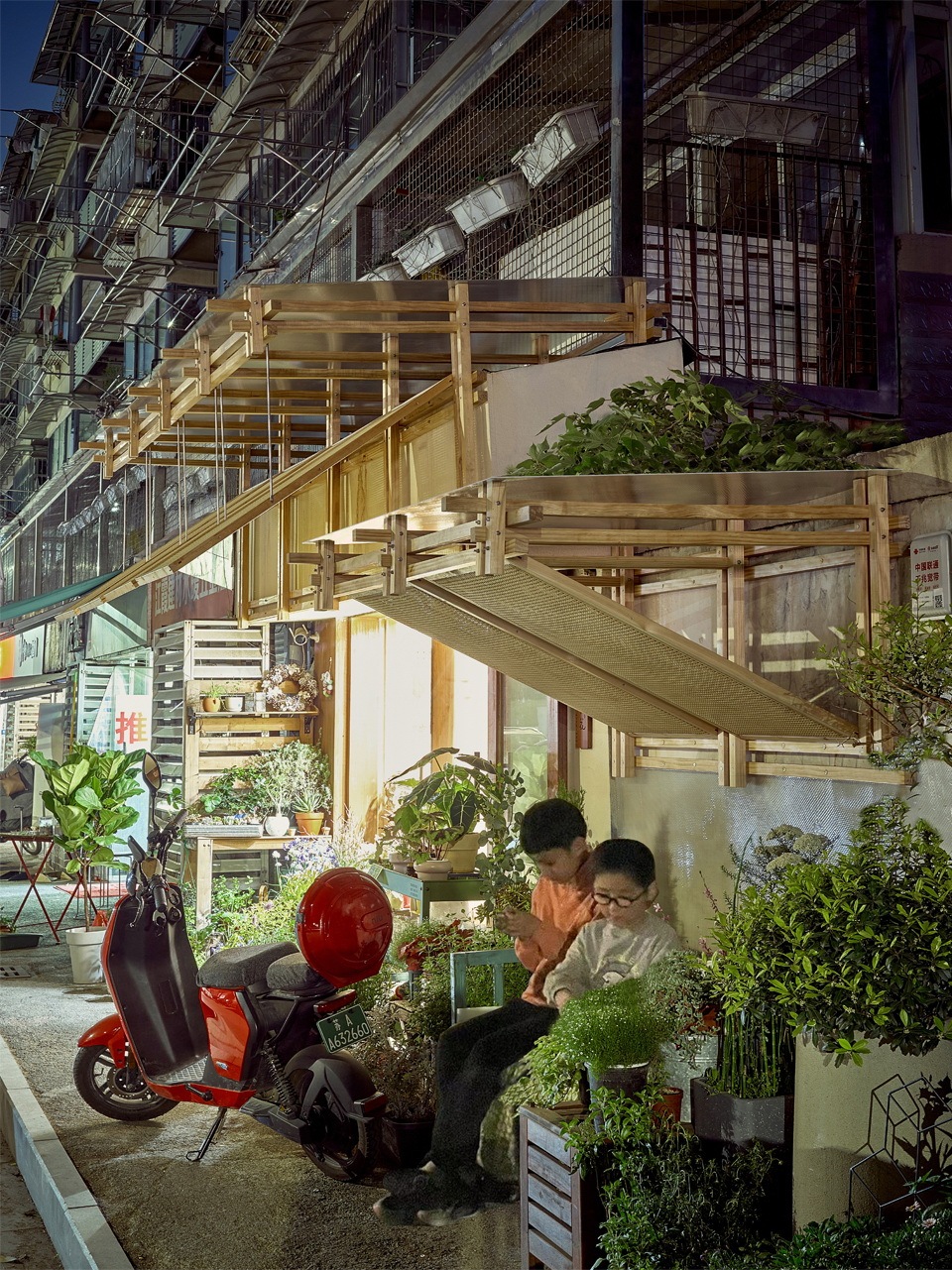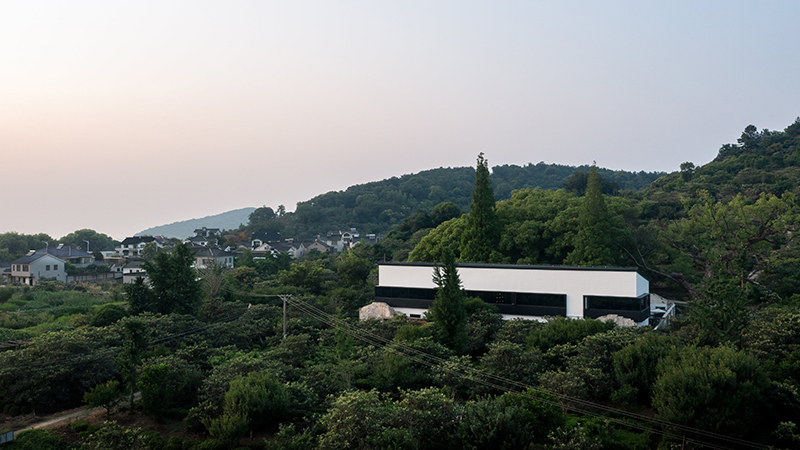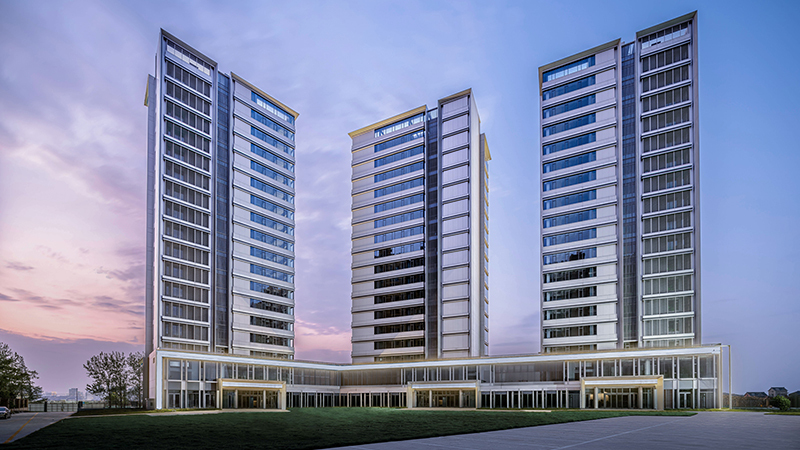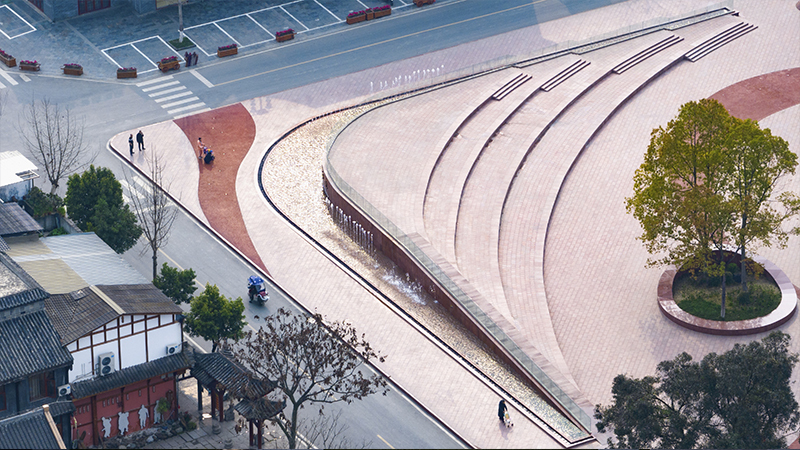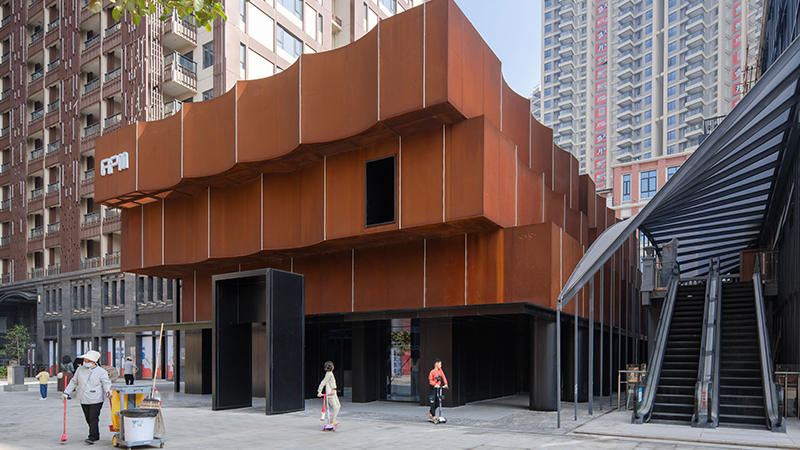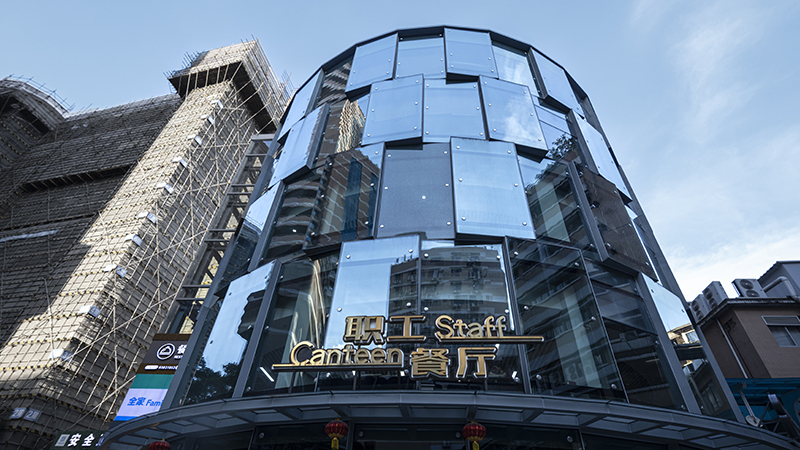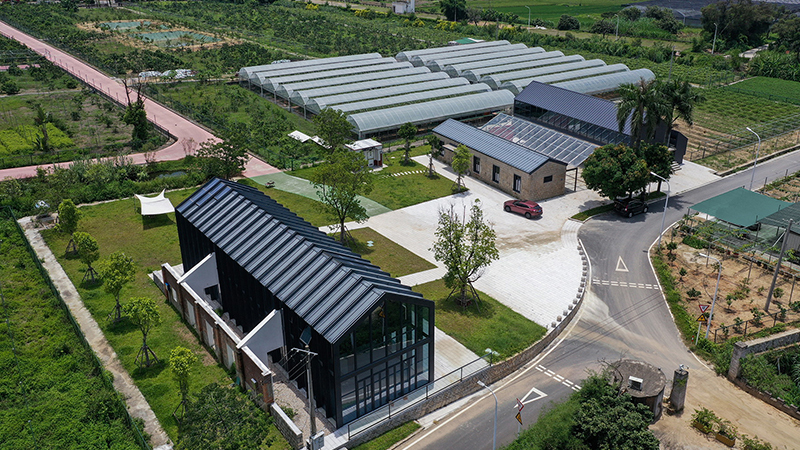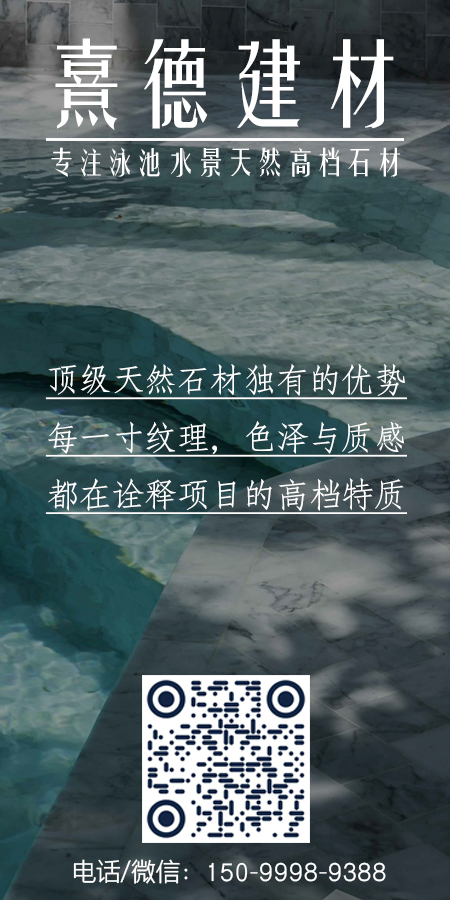笠檐,古人在十里处置笠亭以避风雨、以遮骄阳;故笠者让人联想起避雨遮阳之功能;檐,为本设计的主要建筑构造形式。——笠檐,是好友周博为作品所取的名字。
Li Eaves : The ancients built a pavilion shaped like a bamboo hat on a rural road every ten mils that provides pedestrians with shelter from wind and rain, shade from cold and hot. So “Li” reminds people of its function of providing shelter from rain and sun. Eave is the main architectural construction style for this design. “Li Eaves” was named by our friend Zhou Bo for this project.
笠檐的设计源于好友袁桦的邀约,她接手一家花植店,上任店主留下的铺面已经有一定的视觉品质,对于新增门头的主要诉求是希望能为外摆的花草遮挡夏季强烈的阳光直射;同时能在围墙一侧辟出一个可以休憩的小角落。
We have been invited by our friend Yuan Hua who has newly taken over a Flower and plant shop. The storefront left by the previous owner already possesses a certain visual quality. The main demand for a new storefront is to provide shade for the flowers and plants placed outside, protecting them from the intense direct sunlight in summer. At the same time, it is also hoped that a small corner for rest can be created under the enclosure wall next to the shop.
▼项目概览, Preview
▼烈日炎炎下的遮阳效果, Shading efficiency on a summer day
▼休息区上方与主体相映成趣的反向遮阳扇, Eaves above the bench matching the main eaves lovely in an opposite direction way
花植店位于南京老城中心珠江路南侧,所在的鸡鹅巷是南京传统的街巷空间,街巷两侧住宅底层店铺林立。近年来,随着网红店铺的流行,鸡鹅巷在东西两侧靠近红庙和太平北路的店铺不断升级,而巷子中部仍以五金、杂货、烟酒等商铺为主,品质不高,业态凋敝;但多为居民开设,邻里间相处和睦,街头巷尾自有一种充满烟火气的松弛氛围。
The shop is located in Ji’e Lane on the south side of Zhujiang road, the central area of Nanjing’s main city. Ji’e Lane is a traditional street space in Nanjing, with shops lining the ground floor of residential buildings on both sides. In recent years, with the popularity of trendy shops, the stores at both ends near Hongmiao and Taiping North road have been constantly upgraded and renovated. While, the shops in the middle of the lane are mostly hardware stores, groceries, which are of low quality and outdated in terms of business. However, they are mostly run by the house-owners who are very familiar with each other. The lane is filled with a relaxed and vivid daily life ambiance.
▼花植店在鸡鹅巷所处的位置, Location of the flower and plant shop in Ji’e Lane
未形建筑团队日常以观察阅读城市为趣,并身体力行实践微小更新,为此欣然以自己动手三天焕新为目标,开展这次有趣的建造尝试。
Reading City is a part of our team’s daily work. Also we do some design practices in small-scale urban renewal. In this case, we attempt to renew the storefront within 3 days in a DIY way, which would be an interesting renovating construction practice.
直面当下(关于建造形式的选择)
Directly facing the Present (about the Choice of Construction Form)
笠檐所属的住宅楼建于上世纪八九十年代,具有那个年代典型的外观简陋、造型无特色的状况;其上还叠加着不同时期居民加建、修补以及政府出新的痕迹,呈现出一种偶然与无序的视觉状态。建造最直接的回应是避免过多地触碰原初的建筑物;同时在视觉呈现上想要选择具有一定亲和力和手工痕迹的温暖氛围,以回应传统街巷环境的空间尺度与视觉密度。
The residential building where “Li Eaves” belongs was built in the 1980s and 1990s, with the typical appearance of that era——simple and unremarkable in design. It also has traces of residents' additions, repairs, and government’s renovations in different periods, presenting a visual state of randomness and disorder. The most direct response to the construction is to avoid touching the original building too much. Meanwhile, in terms of visual presentation, we aim to create a warm ambiance with a certain affinity and crafted look in order to respond to the spatial scale and visual density of the traditional lane environment.
▼笠檐与原有住宅楼的关系, Overlapping of “Li Eaves” and the original residential building
形式的概念源于它所要完成的功能诉求:出挑和遮阳。花植店原本就是利用围墙和住宅底层院落的搭建,屋顶和立面并不具备贴建的承受力。出挑对现状的直接回应是越过现状门头,从后部住宅主体二楼阳台底部生根。出挑在门头上部完成后,遮阳面自然采取下挂的方式,笠檐的形式逻辑就此生成。
The concept of the form originates from its functional requirements: overhanging and shading. The flower and plants shop was originally built using the enclosing wall and the courtyard of the residence building. And its roof and facade do not have the structural capacity to support direct attachment. The direct response to the current situation is to take root from the bottom of the second-floor balcony of the main building over the existing signboard. After the overhanging part is completed on the top of the signboard, the shading elements naturally adopt a way of downward-hanging. Thus, the form logic of “Li Eaves” is generated.
▼改造前后空间关系, Sections before and after renovation
▼概念生成图, Generation diagram
▼鸟瞰概念效果图, Aerial view rendering
▼街景人视概念效果图, Rendering view along Ji’e Lane
工业材料与手工制作
Industrial Materials and Handcrafting
为实现快速自主搭建的目标,我们选择易于手工加工的木构方案。所有构件断面统一,选择市场上常见规格的方木,长度根据图纸由厂家切割完成,现场采用螺栓连接的方式组装。
To achieve the goal of rapid and independent assembly, we chose a timber structure system that is easy to manually build. All structural timber components have the same cross-section, which are commonly available in the market. The components are pre-cut by the manufacturer according to the drawings and assembled on-site using bolt connections.
▼材料与构造, Materials and construction
▼不同位置的构造节点, Different wooden joints
▼木构节点所呈现的效果, View presented by wooden joints
遮阳扇片的制作也得益于工业化材料的应用,每片遮阳扇由主副框组成,副框用镂空藤片包裹后固定在主框上。主副框在油画框厂家定制完成,尺寸形状精确,节点可靠,有效降低了现场加工的难度,节省时间,且造价可控。
The production of the sunshade panels also benefits from industrial manufactures. Each sunshade panel consists of a main and a secondary frame, with the secondary frame wrapped in bamboo weaving fabric and then fixed to the main frame. The main and secondary frames are custom-made at an oil painting frame manufacturer, with accurate size and shape, reliable joints,which effectively reduces the difficulty of on-site assembly, saves time, and keeps the cost under control.
▼遮阳扇片安装完成效果, View of the sunshade panels
▼遮阳扇片的光影效果, Lights flowing down through the translucent bamboo weaving fabric
节点密度与视觉感受
Joints Density and Visual Perception
木质传递的温暖气质与花植店的自然气息相得益彰,我们选用小断面短构件来增加节点数量,希望行人能够在近距离内充分感知构件的质感和颗粒度,加强视觉滞留,更生动地传递温暖松弛的氛围。端部节点连接,交叠的杆件层层出挑,蕴含着中国传统木构造的独特意趣。
The warm texture conveyed by the wood complements the natural ambiance of the flower and plant shop. We chose small cross-section short components to increase the number of joints, hoping that pedestrians can fully perceive the texture and granularity of the components at a close distance. Enhancing visual retention helps to convey a warm and relaxed ambiance more vividly. The overlapping timber beams stick out layer by layer for the end joints of the cantilever beams, which reminiscent of the unique charm of traditional Chinese wooden structures.
▼采用不锈钢拉杆下挂的遮阳扇, Sunshade panels hanging down from the cantilever beams with stainless steel rods
▼木杆件层层出挑的端部节点, The overlapping timber beams sticking out layer by layer for the end joints of the cantilever beams
笠檐完工后,得到周围居民的喜欢和认可,吸引不少行人停留、拍照,为巷道空间增添了活力,一定程度上改善了巷道原本的环境品质。
After the completion of “Li eaves”, it has gained the favor of the neighboring residents, attracting many passersby to stop and take photos. To some extent the new construction adds the vitality and improve the original environmental quality of the lane.
▼从街道看花植店, View from Ji’e Lane
▼笠檐与人体尺度的关系, Relationship between “Li eaves” and human scale
这是一次自发的街巷界面更新的尝试,也是一次对城市微型公共空间的积极有益的改造利用。同时,我们也希望通过这样一种使用工业材料进行手工制作的方式,为一些自主更新的建造活动带来一定的专业示范作用。
This is a spontaneous attempt of the street interface renewal, and it is also a positive environmental renovating of urban micro public spaces. At the same time, we also hope that through the method of using industrial materials and handcrafted production, we can provide a certain professional demonstration for some self-renewal construction activities.
▼夜晚灯光下的生活气息, The warm daily life ambiance under the night lights
项目名称:笠檐——花植店街面更新设计
项目类型:社区商业微更新建造实践
设计方:未形建筑
联系邮箱:52444060@qq.com
项目设计:2024
完成年份:2024
设计团队:武恕凡、李亚伟、汪小艳、李刚、芮媛媛、孙榕
项目地址:南京市玄武区鸡鹅巷一枝园北区12号楼
摄影版权:周博、未形建筑
材料:新西兰松木、手工编织仿藤片、阳光板
Project name: Li Eaves–the storefront renewral design for a flower and plants shop
Project type: small-scale renewal construction for community commerce
Design: Raw Architecture Studio
Contact e-mail: 52444060@qq.com
Design year: 2024
Completion Year:2024
Leader designer & Team: Wu Shufan, Li Yawei, Wang Xiaoyan, Li Gang, Rui Yuanyuan, Sun Rong
Project location: Building 12, Yizhiyuan North District, Ji’e Lane, Xuanwu District, Nanjing City
Photo credit: Zhou Bo, RAW
Materials: wood, bamboo weaving fabric, sunlight panel
更新日期:2025-02-11 14:48:09
非常感谢 未形建筑 带来的精彩项目, 查阅更多Appreciations towards Raw Architecture Studio for sharing wonderful work on hhlloo. Click to see more works!
